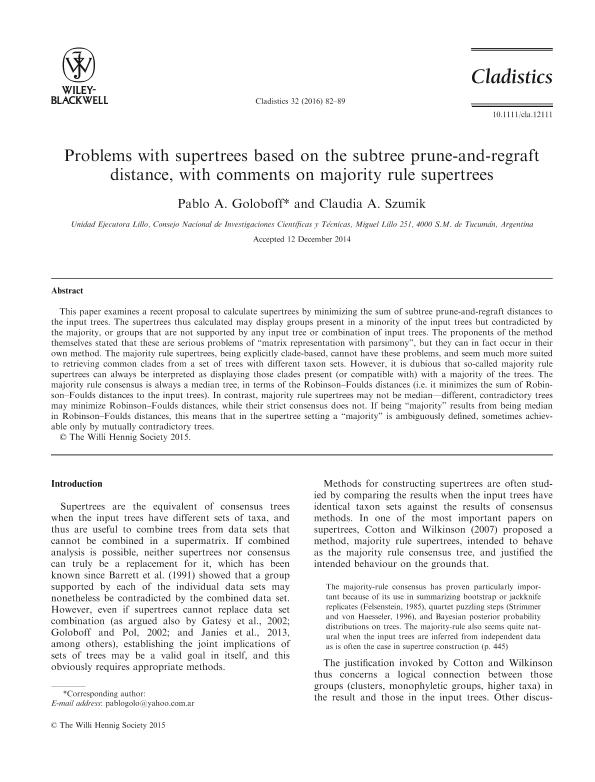Mostrar el registro sencillo del ítem
dc.contributor.author
Goloboff, Pablo Augusto

dc.contributor.author
Szumik, Claudia Adriana

dc.date.available
2018-08-22T16:57:32Z
dc.date.issued
2016-02
dc.identifier.citation
Goloboff, Pablo Augusto; Szumik, Claudia Adriana; Problems with supertrees based on the subtree prune-and-regraft distance, with comments on majority rule supertrees; Wiley Blackwell Publishing, Inc; Cladistics; 32; 1; 2-2016; 82-89
dc.identifier.issn
0748-3007
dc.identifier.uri
http://hdl.handle.net/11336/56578
dc.description.abstract
This paper examines a recent proposal to calculate supertrees by minimizing the sum of subtree prune-and-regraft distances to the input trees. The supertrees thus calculated may display groups present in a minority of the input trees but contradicted by the majority, or groups that are not supported by any input tree or combination of input trees. The proponents of the method themselves stated that these are serious problems of "matrix representation with parsimony", but they can in fact occur in their own method. The majority rule supertrees, being explicitly clade-based, cannot have these problems, and seem much more suited to retrieving common clades from a set of trees with different taxon sets. However, it is dubious that so-called majority rule supertrees can always be interpreted as displaying those clades present (or compatible with) with a majority of the trees. The majority rule consensus is always a median tree, in terms of the Robinson-Foulds distances (i.e. it minimizes the sum of Robinson-Foulds distances to the input trees). In contrast, majority rule supertrees may not be median-different, contradictory trees may minimize Robinson-Foulds distances, while their strict consensus does not. If being "majority" results from being median in Robinson-Foulds distances, this means that in the supertree setting a "majority" is ambiguously defined, sometimes achievable only by mutually contradictory trees.
dc.format
application/pdf
dc.language.iso
eng
dc.publisher
Wiley Blackwell Publishing, Inc

dc.rights
info:eu-repo/semantics/openAccess
dc.rights.uri
https://creativecommons.org/licenses/by-nc-sa/2.5/ar/
dc.subject.classification
Otras Ciencias Biológicas

dc.subject.classification
Ciencias Biológicas

dc.subject.classification
CIENCIAS NATURALES Y EXACTAS

dc.title
Problems with supertrees based on the subtree prune-and-regraft distance, with comments on majority rule supertrees
dc.type
info:eu-repo/semantics/article
dc.type
info:ar-repo/semantics/artículo
dc.type
info:eu-repo/semantics/publishedVersion
dc.date.updated
2018-08-17T16:55:16Z
dc.journal.volume
32
dc.journal.number
1
dc.journal.pagination
82-89
dc.journal.pais
Reino Unido

dc.journal.ciudad
Londres
dc.description.fil
Fil: Goloboff, Pablo Augusto. Consejo Nacional de Investigaciones Científicas y Técnicas. Centro Científico Tecnológico - Tucumán. Unidad Ejecutora Lillo; Argentina
dc.description.fil
Fil: Szumik, Claudia Adriana. Consejo Nacional de Investigaciones Científicas y Técnicas. Centro Científico Tecnológico - Tucumán. Unidad Ejecutora Lillo; Argentina
dc.journal.title
Cladistics

dc.relation.alternativeid
info:eu-repo/semantics/altIdentifier/doi/https://dx.doi.org/10.1111/cla.12111
dc.relation.alternativeid
info:eu-repo/semantics/altIdentifier/url/https://onlinelibrary.wiley.com/doi/abs/10.1111/cla.12111
Archivos asociados
